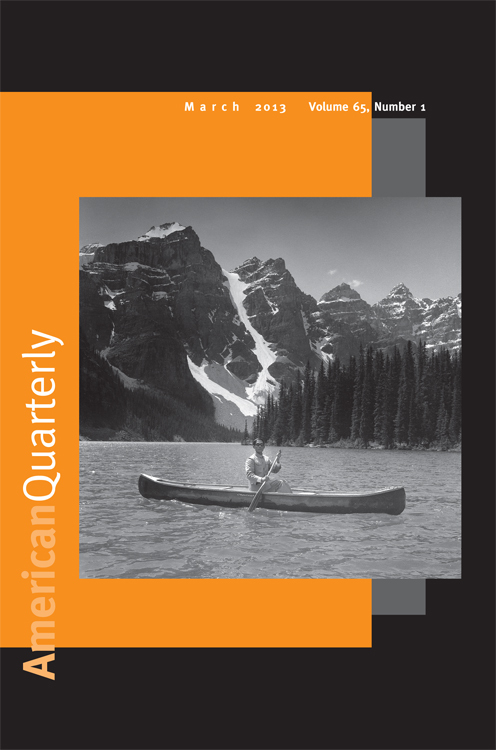In American Quarterly volume 65, issue 1 (March 2013), Matt Delmont assembled a forum on “Visual Culture and the War on Terror.” Assembled below are interactive features provided by several of the forum authors that draw from and elaborate upon the points made in their articles. Explore the supplementary content from this issue.
In American Quarterly volume 65, issue 1 (March 2013), Matt Delmont assembled a forum on“Visual Culture and the War on Terror.” Assembled below are interactive features provided by several of the forum authors that draw from and elaborate upon the points made in their articles. This supplementary webpage begins with its own introduction by Matt Delmont and is followed by contributions from authors Evelyn Asultany, Stacy Takacs, Anjali Nath, Matt Delmont (for his own article), and Erika Doss. To read the forum in its entirety, including authors’ essays that are not mentioned here, please see the print version of the issue.
Visual Culture and the War on Terror
Matt Delmont
This American Quarterly forum explores the continuing centrality of visual culture to the war on terror. As the war on terror creeps through its second decade, the war is both omnipresent and routinely hidden from view. From its initial articulation by the Bush administration in the days after September 11, 2001, to its current incarnation, rebranded the “Oversees Contingency Operation” by the Obama administration, the war on terror has been mediated through an overwhelming array of visual forms and media, including photography, sculpture, painting, film, television, advertisements, cartoons, graphic novels, video games, and the Internet. At the same time, as a “different” kind of conflict, much of the war on terror is conducted covertly and remains, like an end to the war, out of sight.
Each essay in this forum takes up a particular cultural production or set of images in order to trace the contours of visibility and invisibility in the war on terror. Evelyn Alsultany examines the prevalence of sympathetic portrayals of Arabs and Muslims in post-9/11 dramatic television and news media, and shows how these “simplified complex representations” can work to justify discrimination. Sasha Torres extends this focus on televisual representations, considering the complicated relationship between blackness and terrorism in Sleeper Cell and NCIS: Los Angeles. Stacy Takacs explores the information war between the United States and Iran through the case of Amir Mirazaei Hekmati. Hekmati was arrested in Iran and convicted of spying for the CIA based on his association with Kuma Games, whose online gaming series Kuma/War features episodes set in Iraq, Afghanistan, and Iran. Anjali Nath considers how a surreptitious installation by the artist Banksy juxtaposed the figure of a Guantánamo Bay detainee and Disneyland. My essay looks at how Pakistani photojournalist Noor Behram’s photographs of drone strike scenes and Omer Fast’s short film 5000 Feet is the Best use visual tools to critique drone warfare. Finally, Erika Doss examines how two memorials in lower Manhattan—De Oppresso Liber and Reflecting Absence—make claims about how 9/11 should be represented and remembered. Below please find videos, photographs, and links related to each essay.
- Arabs and Muslims in the Media after 9/11: Representational Strategies for a “Post-race” Era, Evelyn Alsultany
- Real War News, Real War Games: The Hekmati Case and the Problems of Soft Power, Stacy Takacs
- Seeing Guantánamo, Blown Up: Banksy’s Installation in Disneyland, Anjali Nath
- Drone Encounters: Noor Behram, Omer Fast, and Visual Critiques of Drone Warfare, Matt Delmont
- De Oppresso Liber and Reflecting Absence: Ground Zero Memorials and the War on Terror, Erika Doss
Arabs and Muslims in the Media after 9/11: Representational Strategies for a “Post-race” Era
Evelyn Alsultany
American-Arab Anti-Discrimination Committee, “Report on Hate Crimes and Discrimination against Arab Americans: The Post-September 11 Backlash,” Washington, DC: American-Arab Anti-Discrimination Committee Research Institute, 2003
For more on the history of representations of Arabs and Muslims, see:
For an example of simplified complex representations in TV dramas, see Sleeper Cell, Season 1, Showtime, December 2005:
For an example of simplified complex representations in journalism, see Lisa Beyer, “The Women of Islam,” Time (November 25, 2001)
Real War News, Real War Games: The Hekmati Case and the Problems of Soft Power
Stacy Takacs
UPDATE: On January 16, 2016, Amir Hekmati and three other American political prisoners were released in exchange for seven Iranian prisoners held in US jails. Thus, ended Hekmati’s four-plus-year ordeal. See Thomas Erdbrink and Rick Gladstone, “Iran Says It Has Released Four Americans in a Prisoner Swap.” New York Times, January 16, 2016.
The Obama administration’s adoption of the philosophy of “smart power” is less a departure from the“hard power” strategy of the Bush era than an extension of it into new realms. In the Information Age, distinctions between hard and soft power have become harder to draw, especially as the “soft” techniques of persuasion and attraction have been placed in service to the “hard” goal of preserving US hegemony. The case of Amir Mirazaei Hekmati, a US citizen arrested in Iran, convicted of spying for the CIA and condemned to death, all for his association with the online gaming company Kuma Games, offers an object lesson in what happens when information becomes a weapon in a boundless war of maneuver.
Here is ABCNews’ coverage of Hekmati’s arrest
Iranian State TV released the following video of Hekmati’s alleged confession. In a letter smuggled out of prison, Hekmati claims the confession was coerced. Flaws in the English transcription of the confession can clearly be heard on the video, and the video itself combines details of the confession with dramatizations of “CIA actions” that look like they are taken from Hollywood feature films:
As I argued in Terrorism TV, popular media have played an important role in the militarization of the social field by glorifying military institutions and exploits and celebrating soldier-subjects and their behaviors. Kuma Games, which makes the online gaming series Kuma/War, participates in this process by “gaming” the War on Terrorism virtually as it happens. Each 10-15 minute episode centers on an “actual” battle engaged in by US forces and incorporates logistical data, satellite imagery and commentary from participants in or witnesses to these events. In addition to working on translation software for Kuma, Amir Hekmati consulted on some of the game modules related to the War in Iraq. This advertisement gives a good sense of the look, feel, and operation of the Kuma/War series.
Two episodes, in particular, have raised the hackles of the Iranian authorities: “Iran Hostage Rescue Mission” and “Assault on Iran.” The first is a two-part episode that allows players to game the aborted Delta Force hostage rescue mission of 1979, but with a different outcome; this time, the US hostages held at the Iranian Embassy are successfully rescued. The second module, “Assault on Iran,” is described as “the most plausible scenario [for] delaying or destroying Iran's nuclear arms capabilities.” In the game, US soldiers infiltrate Iran’s nuclear facility at Natanz, gather incriminating evidence of uranium enrichment, rescue an informer, and blow up the facility. Here is an advertisement for the module:
The Iranian authorities resent the way military-style videogames designed for the US market indiscriminately target Arab and Muslim populations in the Middle East and make their extermination seem necessary to the survival of (Western) civilization. By identifying Kuma Games as a CIA front operation, I think they mean to reframe the US story about its endeavors in the Middle East, thereby depriving the US of “its attractiveness and legitimacy” (i.e. its soft power) in the eyes of others.
Middle Eastern and North African gamers have also begun to counter pro-US first-person-shooter games with their own versions. For example, the Association of Islamic Unions of Students created the game Special Operation 85: Hostage Rescue to counter Kuma’s “Assault on Iran.” In it, players work to free two Iranian nuclear scientists kidnapped by the US.
The Central Intelligence Bureau of Hezbollah has also created two first-person shooters - Special Force 1 & Special Force 2- that allow players to replay key battles from the conflicts between Lebanon and Israel in the 1980s and 2006. In these games, the Israelis are the enemy, and Hezbollah are the heroic underdogs from whose perspective the battles are fought. Here’s the opening clip from “Special Force 2: Tale of the Truthful Pledge” (other segments are also available on Youtube):
This low-intensity, tit-for-tat struggle to shape the interpretation of American power reveals a fundamental coherence between Iran and the US around the question of power politics. Iran has clearly been attracted to and persuaded by the US framing of geopolitics as a militarized power struggle. This has not resulted in enhanced US credibility or trust, however. Instead, the use of soft power as a weapon has subverted cross-cultural dialogue and exchange and made peace harder to attain. Amir Hekmati’s case is a testament to this failure.
Related Links:
- On “smart power,” see: Joseph Nye, “Get Smart: Combining Hard and Soft Power” Foreign Affairs July/August 2009
- Richard Armitage and Joseph Nye, “Center for Strategic and International Studies Commission on Smart Power”
- Eric Etheridge, “How Soft Power Got Smart” New York Times, Opinion Page. January 14, 2009
- Council on Foreign Relations, “Obama's Speech on the Middle East and North Africa, May 2011.” May 19, 2011
- For a critique of “smart power,” see: Paul Cammack, “Smart Power and US Leadership: A Critique of Joseph Nye.” 49th Parallel. Autumn 2008
- Ken Adelman, “Not So Smart Power” Foreign, April 18, 2011
Other popular Kuma/War episodes include:
- “Operation Anaconda” about the first major offensive in the Afghan War
- “Fallujah: Operation Al Fajr” about the Battle for Fallujah
- “The Death of al-Zarqawi” about the “manhunt” for Abu Musab al-Zarqawi, the leader of Al Qaeda in Iraq
- “The Death of Osama Bin Laden” about the Delta Force mission that resulted in the death of Osama Bin Laden
On the politics and ethics of gaming war:
- An early Wired Magazine discussion of Kuma/War
- An MTV story on KumaWar’s “Death of Zarqawi” episode
- “The Battle Over the Battle of Fallujah” (Newsweek/DailyBeast) discusses the ethics of gaming war as it happens
- Nick Robinson, “Videogames, Persuasion, and the War on Terror: Escaping or Embedding the Miltiary-Entertainment Complex?” Political Studies 60.3 (October 2012)
- Roger Stahl, Militainment Inc. NY: Routledge Press, 2009
Seeing Guantánamo, Blown Up: Banksy’s Installation in Disneyland
Anjali Nath
- Banksy’s Guantanamo Detainee Stencil: Street artist Banksy’s stencil graffiti images show up in many different parts of the world, often engaging a variety of political issues. This link to the photo-sharing site Flickr will direct you to a photograph taken by Flickr of a Banksy Guantanamo detainee stencil in England. Banksy’s street art often gets photographed and circulated online through these sites. Accordingly his art is given life both on street walls and within digital public spheres.
- YouTube Video of Banksy's Installation: This brief video from shows edited footage from Banksy's installation at Disneyland in 2006. As you will see, Banksy maneuvers this clandestine installation by masquerading as a park patron. Notably, the tune to "It's a Small World," scores most of this video, from Banksy's entrance to his blowing up of the Guantanamo Detainee doll.
- Banksy’s Detainee Doll at Bristol Museum: After the 2006 Disneyland stunt, Banksy installed the life-size blow up detainee doll at the Bristol Museum during his aptly named “Banksy v. Bristol Museum” exhibition in 2009, where he “remixed” the permanent collection with his own artistic flair. The following two images were uploaded by Flickr users, showing the detainee doll placed inside the Museum’s permanent antique airplane. As I argue in my article, the placement of the doll is critical, and this installation, while fascinating, does not engender the same questions as the Disney exhibit about empire, space, and temporality.
Drone Encounters: Noor Behram, Omer Fast, and Visual Critiques of Drone Warfare
Matt Delmont
In this essay, I consider how Noor Behram’s photographs of drone attack scenes and Omer Fast’s short film 5000 Feet is the Best undermine the supposed precision of drone technology and trouble the invisibility of drone warfare.
The work of Pakistani photojournalist Noor Behram offers visual evidence that contradicts the official discourse of drone strikes taking place with “surgical precision.” Behram’s photographs from an attack in the Dande Darpa Khel region of North Waziristan on August 21, 2009, reflect the larger themes in his work.
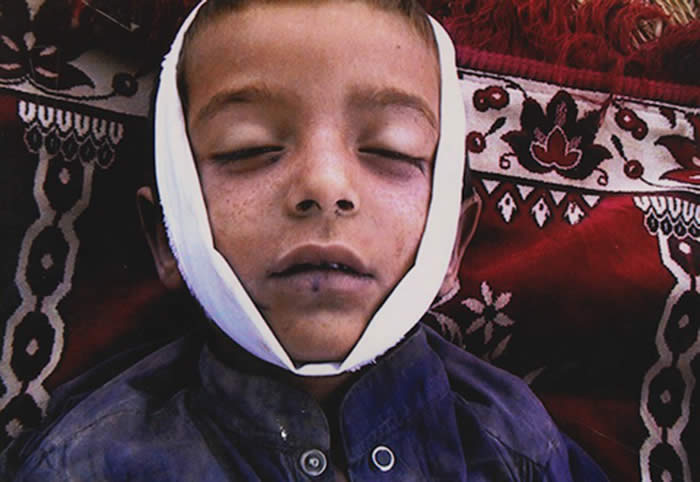
Syed Wali Shah, a seven-year-old boy was killed
in the Dande Darpa Khel attack, along with his parents
Behram’s photographs from the Dande Darpa Khel attack also include an image of Syed Wali Shah’s three siblings, who survived the attack.
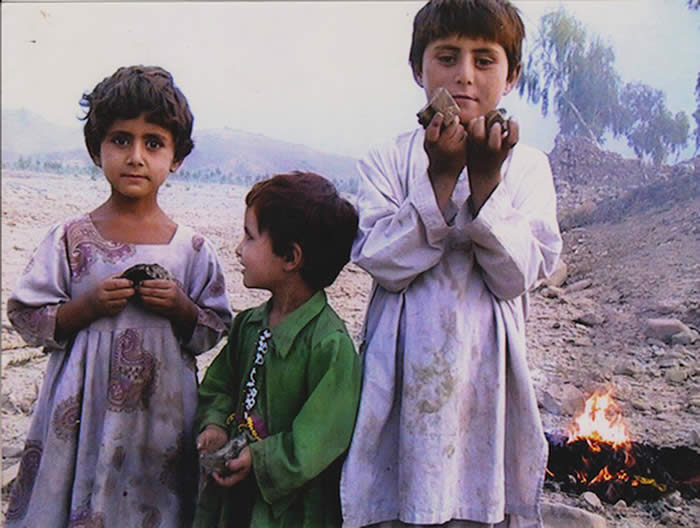
Three children who survived the US drone strike in the Dande Darpa Khel region of North
Waziristan, Pakistan, August 21, 2009. Their parents and sibling were killed in the attack.
Courtesy of Noor Behram/Reprieve.
See also: video of Noor Berham talking to Amna Nawaz, NBC News Pakistan Bureau Chief, about his views of the US drone policy
If Behram’s photographs contest one aspect of the visual power of drones, the ability to “see” and kill precisely and accurately across great distances, Omer Fast’s short film 5000 Feet is the Best offers an imaginative critique of the ability of drones to resist being seen. In a Las Vegas hotel room in fall 2010, Fast conducted two interviews with a former Predator drone pilot turned casino security guard. The video and audio from these interviews appear occasionally in the thirty-minute video, with the pilot’s face and voice obscured. Rather than use these interviews to present a documentary picture of a drone pilot, however, Fast uses the real interviews as small pieces in three fictionalized sequences that use staged interviews with a fictional drone pilot.
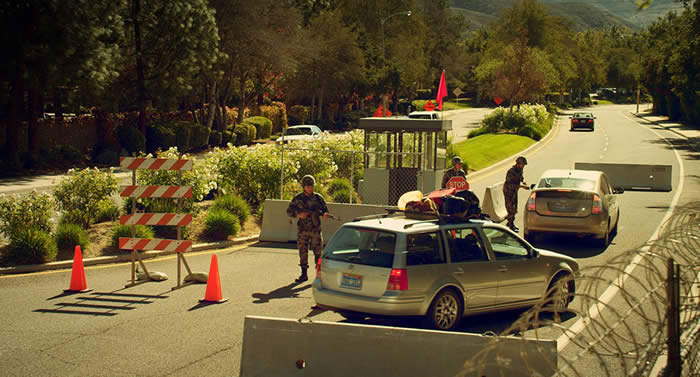
A family stops at a security checkpoint in Omer Fast’s 5000 Feet Is the Best.
Fast’s film deliberately misplaces the war on terror in suburban Las Vegas.
Courtesy of gb agency, Paris.
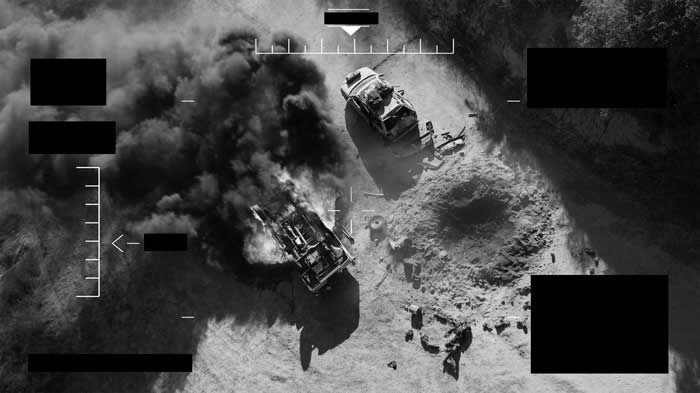
A drone surveys the wreckage of a Hellfire missile attack in Omer Fast’s 5000 Feet Is the Best.
Courtesy of gb agency, Paris.
De Oppresso Liber and Reflecting Absence: Ground Zero Memorials and the War on Terror
Erika Doss
The following links include an interview with artist Douwe Blumberg in his studio in Kentucky and footage of the re-dedication of De Oppresso Liber in New York on October 19, 2012.

